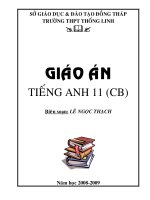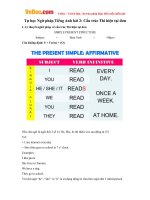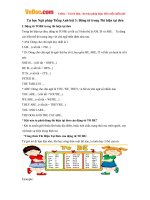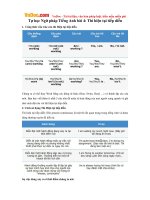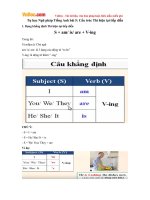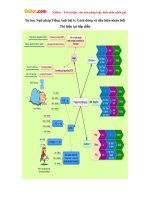- Trang chủ >>
- Đề thi >>
- Đề thi lớp 9
Cách dùng danh từ và mạo từ trong ngữ pháp Tiếng Anh
Bạn đang xem bản rút gọn của tài liệu. Xem và tải ngay bản đầy đủ của tài liệu tại đây (1.2 MB, 14 trang )
<span class='text_page_counter'>(1)</span><div class='page_container' data-page=1>
CÁCH DÙNG DANH TỪ VÀ MẠO TỪ TRONG NGỮ PHÁP TIẾNG ANH
Nouns and Ariticles (Danh từ và mạo từ)
PHẦN A: LÝ THUYẾT
Danh từ (Nouns)
Bất kỳ ngơn ngữ nào khi phân tích văn phạm của nó đều phải nắm được các từ loại của nó và
các biến thể của từ loại này. Trước hết chúng ta tìm hiểu về danh từ là từ loại quen thuộc nhất
và đơn giản nhất trong tất cả các ngôn ngữ.
I. Định nghĩa và phân loại
Trong tiếng Anh danh từ gọi là Noun.
Danh từ là từ để gọi tên một người, một vật, một sự việc, một tình trạng hay một cảm xúc.
Danh từ có thể được chia thành hai loại chính:
Danh từ cụ thể (concrete nouns): chia làm hai loại chính:
Danh từ chung (common nouns): là danh từ dùng làm tên chung cho một loại như: table (cái
bàn), man (người đàn ông), wall (bức tường)…
Danh từ riêng (proper nouns): là tên riêng như: Peter, Jack, England…
Danh từ trừu tượng (abstract nouns): happiness (sự hạnh phúc), beauty (vẻ đẹp), health (sức
khỏe)…
II. Danh từ đếm được và không đếm được (countable and uncountable nouns)
Danh từ đếm được (Countable nouns): Một danh từ được xếp vào loại đếm được khi chúng ta
có thể đếm trực tiếp người hay vật ấy. Phần lớn danh từ cụ thể đều thuộc vào loại đếm được.
Ví dụ: boy (cậu bé), apple (quả táo), book (quyển sách), tree (cây)…
Danh từ không đếm được (Uncountable nouns): Một danh từ được xếp vào loại không đếm
được khi chúng ta không đếm trực tiếp người hay vật ấy. Muốn đếm, ta phải thông qua một
đơn vị đo lường thích hợp. Phần lớn danh từ trừu tượng đều thuộc vào loại khơng đếm được.
Ví dụ: meat (thịt), ink (mực), chalk (phấn), water (nước)…
Số nhiều của danh từ
Một được xem là số ít (singular). Từ hai trở lên được xem là số nhiều (plural). Danh từ
thay đổi theo số ít và số nhiều
I. Nguyên tắc đổi sang số nhiều
1. Thông thường danh từ lấy thêm S ở số nhiều.
Ví dụ: chair – chairs ; girl – girls ; dog – dogs
2. Những danh từ tận cùng bằng O, X, S, Z, CH, SH lấy thêm ES ở số nhiều.
Ví dụ: potato – potatoes ; box – boxes ; bus – buses ; buzz – buzzes ; watch – watches ; dish –
dishes
Ngoại lệ:
a) Những danh từ tận cùng bằng nguyên âm + O chỉ lấy thêm S ở số nhiều.
Ví dụ: cuckoos, cameos, bamboos, curios, studios, radios
</div>
<span class='text_page_counter'>(2)</span><div class='page_container' data-page=2>
Ví dụ: pianos, photos, dynamo, magnetos, kilos, mementos, solos
3. Những danh từ tận cùng bằng phụ âm + Y thì chuyển Y thành I trước khi lấy thêm ES.
Ví dụ: lady – ladies ; story – stories
4. Những danh từ tận cùng bằng F hay FE thì chuyển thành VES ở số nhiều.
Ví dụ: leaf – leaves, knife – knives
Ngoại lệ:
a) Những danh từ sau chỉ thêm S ở số nhiều:
roofs : mái nhà
gulfs : vịnh
cliffs : bờ đá dốc
reefs : đá ngầm
proofs : bằng chứng
chiefs : thủ lãnh
turfs : lớp đất mặt
safes : tủ sắt
dwarfs : người lùn
griefs : nỗi đau khổ
beliefs : niềm tin
b) Những danh từ sau đây có hai hình thức số nhiều:
scarfs, scarves : khăn quàng
wharfs, wharves : cầu tàu gỗ
staffs, staves : cán bộ
hoofs, hooves : móng guốc
II. Cách phát âm S tận cùng
S tận cùng (ending S) được phát âm như sau:
1. Được phát âm là /z/: khi đi sau các nguyên âm và các phụ âm tỏ (voiced consonants), cụ thể
là các phụ âm sau: /b/, /d/, /g/, /v/, /T/, /m/, /n/, /N/, /l/, /r/.
Ví dụ: boys, lies, ways, pubs, words, pigs, loves, bathes, rooms, turns, things, walls, cars.
2. Được phát âm là /s/: khi đi sau các phụ âm điếc (voiceless consonants), cụ thể là các phụ
âm sau: /f/,
/k/, /p/, /t/ và /H/.
Ví dụ: laughs, walks, cups, cats, tenths.
3. Được phát âm là /iz/: khi đi sau một phụ âm rít (hissing consonants), cụ thể là các phụ âm
sau: /z/, /s/,
/dZ/, /tS/, /S/, /Z/.
</div>
<span class='text_page_counter'>(3)</span><div class='page_container' data-page=3>
1. Những danh từ sau đây có số nhiều đặc biệt:
man – men : đàn ông
woman – women : phụ nữ
child – children : trẻ con
tooth – teeth : cái răng
foot – feet : bàn chân
mouse – mice : chuột nhắt
goose – geese : con ngỗng
louse – lice : con rận
2. Những danh từ sau đây có hình thức số ít và số nhiều giống nhau:
deer : con nai sheep : con cừu
swine : con heo
Mạo từ (Article)
Trong tiếng Việt ta vẫn thường nói như: cái nón, chiếc nón, trong tiếng Anh những từ có ý
nghĩa tương tự như cái và chiếc đó gọi là mạo từ (Article).
Tiếng Anh có các mạo từ: the /Tə/, a /ən/, an /ân/
Các danh từ thường có các mạo từ đi trước.
Ví dụ: the hat (cái nón), the house (cái nhà), a boy (một cậu bé)…
The gọi là mạo từ xác định (Definite Article), the đọc thành /Ti/ khi đứng trước một danh từ bắt
đầu bằng một nguyên âm hay phụ âm điếc (phụ âm h thường là một phụ âm câm như hour
(giờ) không đọc là /hau/ mà là /auə/).
Ví dụ: the hat /hỉt/ nhưng the end /Ti end/
the house /Tə haus/ the hour /Ti auə/
A gọi là mạo từ không xác định hay bất định (Indefinite Article). A được đổi thành an khi đi
trước một danh từ bắt đầu bằng một nguyên âm hay phụ âm điếc. Ví dụ:
a hat (một cái nón) nhưng an event (một sự kiện)
a boy (một cậu bé) nhưng an hour (một giờ đồng hồ)
và
a unit khơng phải an unit vì âm u được phát âm là /ju/ (đọc giống như /zu/).
Mạo từ bất định a được đọc là [ə] ở các âm yếu; đọc là [ei] trong các âm mạnh.
a/an đặt trước một danh từ số ít đếm được và được dùng trong những trường hợp sau đây:
1. Với ý nghĩa một người, một vật. một cái bất kỳ.
I have a sister and two brothers. (Tơi có một người chị và hai người anh)
2. Trong các thành ngữ chỉ một sự đo lường.
He works forty-four hours a week. (Anh ấy làm việc 44 giờ một tuần)
</div>
<span class='text_page_counter'>(4)</span><div class='page_container' data-page=4>
4. Trước các bổ ngữ từ (complement) số ít đếm được chỉ nghề nghiệp, thương mại, tôn giáo,
giai cấp v… v..
George is an engineer.(George là một kỹ sư)
The King made him a Lord. (Nhà Vua phong cho ông ta làm Huân tước)
5. Trước một danh từ riêng khi đề cập đến nhân vật ấy như một cái tên bình thường.
A Mr. Johnson called to see you when you were out.(Một Ô. Johnson nào đó đã gọi để gặp bạn
khi bạn ra ngoài)
6. Với ý nghĩa cùng, giống (same) trong các câu tục ngữ, thành ngữ.
They were much of a size. (Chúng cùng cở)
Birds of a feather flock together. (Chim cùng loại lông hợp đàn với nhau – Ngưu tầm ngưu, mã
tầm mã)
7. Trước một ngữ đồng vị (appositive) khi từ này diễn tả một ý nghĩa không quen thuộc lắm.
He was born in Lowton, a small town in Lancashire.(Ông ấy sinh tại Lowton, một thành phố nhỏ
ở Lancashire)
8. Trong các câu cảm thán (exclamatory sentences) bắt đầu bằng ‘What’ và theo sau là một
danh từ số ít đếm được.
What a boy! (Một chàng trai tuyệt làm sao!)
9. Trong các thành ngữ sau (và các cấu trúc tương tự):
It’s a pity that… : Thật tiếc rằng…
to keep it a secret : giữ bí mật
as a rule : như một nguyên tắc
to be in a hurry : vội vã
to be in a good/bad temper : bình tĩnh/cáu kỉnh
all of a sudden : bất thình lình
to take an interest in : lấy làm hứng thú trong
to make a fool of oneself : xử sự một cách ngốc nghếch
to have a headache : nhức đầu
to have an opportunity to : có cơ hội
at a discount : giảm giá
on an average : tính trung bình a short time ago : cách đây ít lâu
10. Trong các cấu trúc such a; quite a; many a; rather a.
I have had such a busy day.
II. Không sử dụng Mạo từ bất định
Mạo từ bất định không được sử dụng trong các trường hợp sau:
1. Trước một danh từ chỉ một tước hiệu, cấp bậc hay một chức danh chỉ có thể giữ bởi một
người trong một thời điểm nào đó.
</div>
<span class='text_page_counter'>(5)</span><div class='page_container' data-page=5>
As Chairman of the Society, I call on Mr. Brown to speak. (Trong tư cách là Chủ tịch Hiệp hội,
tơi mời Ơ.Brown đến nói chuyện)
2. Trước những danh từ không đếm được (uncountable nouns) nói chung.
He has bread and butter for breakfast. (Anh ấy ăn sáng với bánh mì và bơ)
She bought beef and ham. (Cơ ấy mua thit bị và thịt heo)
3. Trước các danh từ chỉ các bữa ăn nói chung.
They often have lunch at 1 o’clock. (Họ thường ăn trưa lúc một giờ)
Dinner will be served at 5 o’clock. (Bữa ăn tối sẽ được dọn lúc 5 giờ)
4. Trước các danh từ chỉ một nơi công cộng để diễn tả những hành động thường được thực
hiện tại nơi ấy.
He does to school in the morning. (Anh ta đi học vào buổi sáng)
They go to market every day. (Họ đi chợ mỗi ngày)
5. Trước các danh từ chỉ ngày, tháng, mùa.
Sunday is a holiday. (Chủ nhật là một ngày lễ)
They often go there in summer. (Họ thường đến đó vào mùa hè)
6. Sau động từ turn với nghĩa trở nên, trở thành.
He used to be a teacher till he turned writer. (Ông ấy là một giáo viên trước khi trở thành nhà
văn)
The được phát âm là [T] khi đi trước các nguyên âm, là [Ti] trước các nguyên âm, là [Ti:] khi
được nhấn mạnh.
Mạo từ xác định the được dùng trước danh từ số ít lẫn số nhiều, cả đếm được cũng như không
đếm được.
I. The thường được sử dụng trong các trường hợp sau đây:
1. Khi đi trước một danh từ chỉ người hay vật độc nhất.
The sun rises in the east.
2. Với ý nghĩa “người hay vật mà chúng ta vừa đề cập đến”
Once upon a time there was a little boy who lived in a cottage. The cottage was in the country
and the boy had lived there all his life.
3. Trước tên các quốc gia ở dạng số nhiều hoặc các quốc gia là sự liên kết các đơn vị nhỏ.
The United States; The Netherlands
4. Trước các địa danh mà danh từ chung đã được hiểu ngầm.
The Sahara (desert); The Crimea (peninsula)
5. Trước danh từ riêng chỉ quần đảo, sông, rặng núi, đại dương.
The Thames; The Atlantic; The Bahamas
6. Trước một danh từ số ít đếm được dùng với ý nghĩa tổng quát để chỉ cả một chủng loại.
The horse is being replaced by the tractor.
</div>
<span class='text_page_counter'>(6)</span><div class='page_container' data-page=6>
8. Trước một tước hiệu gọi theo số thứ tự.
Queen Elizabeth II (Queen Elizabeth the Second)
9. Trong dạng so sánh nhất (superlatives) và trong dạng so sánh kép (double comparative)
This is the youngest student in my class.
The harder you work, the more you will be paid.
10. Trước một danh từ được một ngữ giới từ (prepositional phrase) bổ nghĩa.
the road to London; the battle of Trafalgar
11. Trước một danh từ được bổ nghĩa bằng một một mệnh đề quan hệ xác định (defining
relative clause).
The man who helped you yesterday is not here.
12. Trước một tính từ để tạo thành một danh từ tập hợp (collective noun).
The rich should help the poor.
II. Không dùng mạo từ xác định “The”
The không được dùng trong các trường hợp sau đây:
1. Trước những danh từ trừu tượng dùng theo nghĩa tổng quát.
Life is very hard for some people (not: The life)
2. Trước các danh từ chỉ chất liệu dùng theo nghĩa tổng quát.
Butter is made from cream (not: The butter)
3. Trước tên các bữa ăn dùng theo nghĩa tổng quát.
Dinner is served at 6:00 (not: The dinner)
4. Trước các danh từ số nhiều dùng theo nghĩa tổng quát.
Books are my best friends. (not: The books)
5. Trước hầu hết các danh từ riêng.
He lived in London (not: The London)
6. Trước các từ Lake, Cape, Mount.
Lake Superior, Cape Cod, Mount Everest
7. Trước các tước hiệu có danh từ riêng theo sau.
King George, Professor Russell
8. Trước các danh từ chỉ ngôn ngữ.
Russian is more difficult than English. (not: The Russian)
9. Trước tên các mùa và các ngày lễ.
Winter came late that year (not: The winter)
10. Trước các danh từ chung chỉ một nơi công cộng nhằm diễn đạt ý nghĩa làm hành động
thường xảy ra ở nơi ấy.
</div>
<span class='text_page_counter'>(7)</span><div class='page_container' data-page=7>
PHẦN B: VÍ DỤ
Put in the or al an where necessary.
Jason’s Father bought him______bicycle that he had wanted for his birthday. Statue of Liberty
was a gilt of friendship from France_____ to United States.
Rita is studying_____English and_____math this semeter.
_____Judge asked_____witness to tell_____truth.
Please give me_____cup of_____coffee with_____cream and_____sugar.
_____big books on_____table are for my history class.
No one in_____Spanish class knew_____correct answer to_____Mrs Brown’s question.
My____ car is four years old, and it still runs well.
When you go to_____store, please buy_____bottle of_____chocolate milk and_____dozen
oranges.
There are only_____few seats left for_____tonight’s musical show at _____university.
]ohn and Mary went to_____school yesterday and then studied in_____library before returning
home.
_____Lake Erie is one of_____five great Lakes in_____North America.
On our trip to_____Spain, we crossed_____Atlantic Ocean.
_____Mount Rushmore is the site of magnificent tribute to_____four great American presidents.
What did you eat for_____breakfast this morning?
David played_____basketball and_____baseball at_____Boy’s club this year.
Rita plays_____ violon and her sister plays
While we were in_____Alaska, we saw_____Eskimo village.
Tom can’t go to_____movies tonight because he has to write
David attended_____Princeton University.
Harry has been admitted to _____School of Medicine at_____mid western University.
Mel’s grandmother is in_____hospital, so we went to visit her_____last night.
_____political Science class is taking_____trip to_____France in_____
_____Queen Elizabeth II is monarch of_____Great Britain.
Scientists sent_____expedition to_____Mars during_____1990s.
Last night there was_____bird singing outside my house.
_____chair that you are sitting in is broken.
_____Civil War was fought in_____United States between 1861 and 1865.
_____Florida State University is smaller than_____University of Florida.
There was_____knock on_____door. I opened it and found_____small dark man in_____blue
overcoat and_____woolen cap.
-Do you know_____time?
</div>
<span class='text_page_counter'>(8)</span><div class='page_container' data-page=8>
-Then it isn’t_____time to go yet.
_____listening to_____teacher is useful for all of us.
Most of_____students vvorking in_____garden are tired.
He works as_____assistant in_____same shop as I do.
Do you think I should go to_____police?
To prevent_____possible repetition of this accident, I lent him
Most_____farmers working hard on their land almost get nothing for their lifetime.
Do you see_____man standing near_____door?
I told you about_____burglary that we had at_____shop, didn’t I?
______practicing English everyday of all the students in our class is very necessary.
The United Nations is_____international organization founded in 1945 after_____World War II
by 51 countries.
Rachel Carson was born in 1907 in_____Pennsylvania. She studied Biology and_____Zoology
at_________________________ Johns Hopkins University, where she received her master’s
degree in 1933.
Although they are_____inexpensive supplier of vitamins, minerals, and high- quality protein,
_____eggs also contain_____high level of blood cholesterol, one of_____major causes of heart
diseases.
_____hippopotamus is_____third largest land animal, smaller only than_____elephant
and_____rhinoceros.
_____White House, the official home of United States presidents, was not built in time for
George Washington to live in it.
_____lot of people catch_____flu during the winter.
Doing _____ exercise regularly is effective and successful stress treatment for its bad
We already know that_____smoking is_____trigger for_____asthma.
_____work of the United Nations reaches every corner of_____globe.
When you go to_____seaside, remember not to swim near_____rocks.
ĐÁP ÁN
1. the 2. The, Ø, the 3. Ø,Ø
4. The, the,the
5. a, Ø,Ø,Ø
6. The, the 7. the(Ø), the, Ø
8. Ø
9. the, a, Ø, a 10. a, Ø,the
11. Ø, the 12. Ø,the, Ø
13. Ø, the 14. Ø, a(the), Ø
15. Ø
</div>
<span class='text_page_counter'>(9)</span><div class='page_container' data-page=9>
17. the(Ø), the (Ø)
18. Ø, an 19. the, an 20. Ø
21. the, a 22. Ø,Ø 23. The, a , Ø,Ø
24. Ø, the, Ø
25. an, Ø, the
26. a
27. The
28. The, the
29. Ø, the
30. a, the, a, a, a
31. the, a, the, Ø
32. Ø, the 33. the, the 34. an, the 35. the
36. the, a 37. Ø 38. the, the 39. the, a 40. The
41. an, Ø 42. Ø, Ø, Ø, Ø 43. an, Ø, a, the
44. The, the, the, the
45. The, the
46. A, a 47. Ø, an 48. Ø, a, Ø 49. The, the 50. the, the
PHẦN C: BÀI TẬP VẬN DỤNG
I. Read the passage then classify the nouns into: proper nouns, common nouns,
concrete nouns, abstract nouns, countable nouns, uncountable nouns.
“It was a great treat to be away from the City and to breathe the clean air of the countryside.
The rain had ceased and the sun was shining again as I drove up to the
door. My friends came out to welcome me “You’re brought the sun”, they said.
We went into the house, chattering and laughing, while the dogs crowded round us, brushing up
against us in welcome. “We’re all going into the forest this evening”, my friend said – “We want
to show you the young deer – We haven’t been able to go out for some days. It’s been too wet”.
II. Read the passage and then identify the functions of the nouns.
He soon grew accustomed to all our ways. He insisted, for example, on having his meals with
us, and these had to be exactly the same as ours. He ate on the window ledge out of the
saucer. For breakfast, he would have porridge or corn-flakes, with warm milk and sugar, while
at lunch he had green vegetables and potatoes and a spoonful of sweet pudding. At tea-time he
had to be kept off the the table, or he would dive into the jam-pot with cries of delight. We had
to learn to be careíul not to close doors without looking up first, in case he was crouching on
top. His moods were like those of a child. When he was feeling affectionate, he would come
along with a loving expression on his face, climb on your shoulder and give your ear a playful
bite.
III. Write plural forms of the nouns below and then group them according to the
pronunciation of -s, -es.
</div>
<span class='text_page_counter'>(10)</span><div class='page_container' data-page=10>
IV. Choose the correct verb forms.
The picture of the soldiers (bring/ brings) back many memories.
Anything (is/ are) better than going to the play tonight.
A number of reporters (was/ were) at the conference yesterday.
There (was/ were) some people at the meeting last night.
Each student (has/ have) answered the íìrst three questions.
Either John or his wife (make/ makes) breakfast each morning.
The army (has/ have) eliminated this section of the training test.
The number of students who have withdrawn from class this quarter (is/ are) appalling.
These pictures as well as photograph (brighten/ brightens) the room.
Gymnastics (is/ are) my favourite sport.
The trousers you bought for me (doesn’t/ don’t) fit me.
Where (do/ does) your family live?
Three days (isn’t/ aren’t) long enough for a good holiday.
What he told you (seem/ seems) to be of no importance
Measles (is/ are) cured without much difficulty nowadays.
Neither the moon nor stars (is/ are) visible in this dark night.
Wheat (is/ are) used to make flour.
The staíĩ (was/ were) opposed to any change.
Fortunately the news (wasn’t/ weren’t) as bad as we expected.
I don’t like very hot weather. Thirty degree (is/ are) too warm for me.
The list of ỉtems (is/are) on the desk.
The politician, along with the newsmen, (is /are) expected to come shortly.
Excitement, as weli as nervousness, (is / are) the cause of her shaking.
Three miles (is / are) too far to walk.
Five years (is / are) the maximum sentence for that oẩense.
The colors of the rainbow (is / are) beautiful.
Red beans and rice (is / are) my mom’s favorite dỉsh.
Few (was/were) left alive after the flood.
Ten dollars (is/are) a high price to pay.
Black or white (is, are) your choice.
Each of the students (is/are) responsible for doing his or her work in the library.
Here (is/are) two apples for your breakfast.
Diabetes (is/are) a dangerous disease for pregnant women.
My assets (was/were) wiped out in the depression.
</div>
<span class='text_page_counter'>(11)</span><div class='page_container' data-page=11>
Our thanks (go/goes) to the workers who supported the union.
Some of the votes (seem/seems) to have been miscounted.
The tornadoes that tear through this county every spring (is/are) more than just a nuisance.
He seems to forget that there (is/are) things to be done before he can graduate.
Some of the grain (appear/appears) to be contaminated.
V. Join the two or three nouns, using ’s or o/.
The mother/ Ann
The top/ the page
The newspaper/ yesterday
The name/ this Street
The garden/ our neighbours
The chỉldren/ Don and Mary
The wedding/ the ữiend/ Helen
The ground floor/ the building
The car/ the parents/ Mike
The economic policy/ the government
VI. Sentence transformation.
Wedding presents received by John were manificent.
->John’s___________________________________
The storm which happened last week caused a lot of damage.
-> Last week’s______________________________
The meeting which will take place tomorrow has been cancelled.
-> Tomorrow’s______________________________
John has blue eyes.
->The color________________________________
Mary has an old car, which needs repairing.
-> Mary’s__________________________________
]anet had a barbecue, which was very funny.
-> ]anet’s__________________________________
After they had separated for three years, they reunited in excitement.
-> After three years’ __________________________
ĐÁP ÁN
I. treat: common abstract countable noun
</div>
<span class='text_page_counter'>(12)</span><div class='page_container' data-page=12>
– rain: common abstract uncountable noun
– sun: common abstract countable noun
– door: common abstract countable noun
– friends: common abstract countable noun
– house: common abstract countable noun
– dogs: common abstract countable noun
– welcome: common abstract uncountable noun
– forest: common abstract countable noun
– deer: common abstract countable noun
– days: common abstract countable noun
II.
– ways: object of preposition – meals: object
– window ledge: object of preposition – saucer: object of preposition
– breakfast: object of preposition – porridge: object
– cornflakes: object – milk: object of preposition
– sugar: object of preposition – lunch: object of preposition
– vegetables, potatoes: object – pudding: object of preposition
– tea-time: object of preposition – table: object of preposition
– jam-pot: object of preposition – cries of delight: object of preposition
– doors: object – mood: subject
– child: object of preposition expression: object of preposition
– face: object of preposition – shoulder: object of preposition
– ear: direct object – bite: direct object
III.
Beds, churches, roofs/rooves, taxis, dishes, maps, cats, books, dogs, rooms, boys, sizes,
houses, forces, changes, places pencils, guests, listeners, things, pedestrians, sentences.
/s/ roofs, maps, cats, books, guets
/z/ beds, rooves, dogs, rooms, boys, pencils, listeners, things, pedestrians
/iz/ churches, taxis, dishes, sixes, houses, forces changes, places, santences
IV.
</div>
<span class='text_page_counter'>(13)</span><div class='page_container' data-page=13>
17. is 18. were 19.wasn’t 20. is 21. is 22. is 23. is 24. is
25. is 26. are 27. is 28.were 29. is 30. is 31. is 32. are
33. is 34.were 35.have 36.goes 37.seem 38. are 39.are 40.appears
V.
1. Ann;s mother
2. the top of the page
3. yesterday’s newspaper
4. the name of this street
5. our neighnours’garden
6. Don ang Mary’s children
7. Helen’s friend’s wedding
8. the ground floor of the building
9. Mike’s parents’car
10. the economic policy of the government (the government’s economic policy)
VI.
1. John’s wedding presents were manificent
2. Last week’s storm caused a lot of damage
3. Tomorrow’s meeting has been cancelled.
4. The color of John’s eyes is blue.
5. Mary’s old car needs repairing.
6. Jane’s barbrcue was very funnt.
</div>
<span class='text_page_counter'>(14)</span><div class='page_container' data-page=14>
Website HOC247 cung cấp một môi trường học trực tuyến sinh động, nhiều tiện ích thơng
minh, nội dung bài giảng được biên soạn công phu và giảng dạy bởi những giáo viên nhiều
năm kinh nghiệm, giỏi về kiến thức chuyên môn lẫn kỹ năng sư phạm đến từ các trường
Đại học và các trường chuyên danh tiếng.
I. Luyện Thi Online
- Luyên thi ĐH, THPT QG: Đội ngũ GV Giỏi, Kinh nghiệm từ các Trường ĐH và THPT danh
tiếng xây dựng các khóa luyện thi THPTQG các mơn: Tốn, Ngữ Văn, Tiếng Anh, Vật Lý,
Hóa Học và Sinh Học.
- Luyện thi vào lớp 10 chun Tốn: Ơn thi HSG lớp 9 và luyện thi vào lớp 10 chuyên
Toán các trường PTNK, Chuyên HCM (LHP-TĐN-NTH-GĐ), Chuyên Phan Bội Châu Nghệ
An và các trường Chuyên khác cùng TS.Trần Nam Dũng, TS. Phạm Sỹ Nam, TS. Trịnh Thanh
Đèo và Thầy Nguyễn Đức Tấn.
II. Khoá Học Nâng Cao và HSG
- Tốn Nâng Cao THCS: Cung cấp chương trình Tốn Nâng Cao, Toán Chuyên dành cho các
em HS THCS lớp 6, 7, 8, 9 u thích mơn Tốn phát triển tư duy, nâng cao thành tích học
tập ở trường và đạt điểm tốt ở các kỳ thi HSG.
- Bồi dưỡng HSG Tốn: Bồi dưỡng 5 phân mơn Đại Số, Số Học, Giải Tích, Hình Học và Tổ
Hợp dành cho học sinh các khối lớp 10, 11, 12. Đội ngũ Giảng Viên giàu kinh nghiệm: TS. Lê
Bá Khánh Trình, TS. Trần Nam Dũng, TS. Phạm Sỹ Nam, TS. Lưu Bá Thắng, Thầy Lê Phúc
Lữ, Thầy Võ Quốc Bá Cẩn cùng đơi HLV đạt thành tích cao HSG Quốc Gia.
III. Kênh học tập miễn phí
- HOC247 NET: Website hoc miễn phí các bài học theo chương trình SGK từ lớp 1 đến lớp
12 tất cả các môn học với nội dung bài giảng chi tiết, sửa bài tập SGK, luyện tập trắc nghiệm
mễn phí, kho tư liệu tham khảo phong phú và cộng đồng hỏi đáp sôi động nhất.
- HOC247 TV: Kênh Youtube cung cấp các Video bài giảng, chuyên đề, ôn tập, sửa bài tập,
sửa đề thi miễn phí từ lớp 1 đến lớp 12 tất cả các mơn Tốn- Lý - Hố, Sinh- Sử - Địa, Ngữ
Văn, Tin Học và Tiếng Anh.
Vững vàng nền tảng, Khai sáng tương lai
Học mọi lúc, mọi nơi, mọi thiết bi – Tiết kiệm 90%
Học Toán Online cùng Chuyên Gia
</div>
<!--links-->

